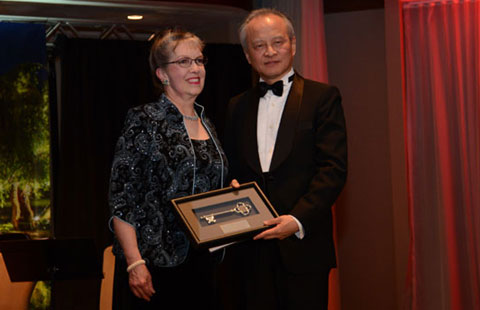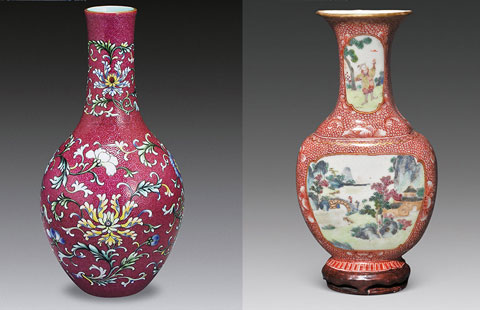Toward progress of friendship and inclusive development
Updated: 2014-12-22 07:46
(China Daily)
|
||||||||
First, we need to deepen cooperation in infrastructure. GMS countries are all at a critical stage of development. Transport and other infrastructure building will form new growth areas for economic development and employment creation, and connectivity building on the Indo-China Peninsula will provide an important guarantee for economic integration in the Lancang-Mekong subregion. The Silk Road Economic Belt and the 21st Century Maritime Silk Road initiatives put forward by China will bring new opportunities for us to deepen cooperation at the subregional level. The memorandum of understanding signed between China and Thailand yesterday on railway cooperation is important agreement reached between the two sides after two years of hard work. This railway, the first modern standard gauge line on the Indo-China Peninsula, will be built entirely with Chinese technology and equipment and will be supported by Chinese funding as needed. It will surely boost development of the Pan-Asia rail links on the peninsula. I am confident that the construction of the railway line will be of high quality and highly efficient. The parties concerned need to take the establishment of the Greater Mekong Railway Association as the opportunity to develop comprehensive connectivity facilities, including highways, railways and shipping links at the subregional level. At the same time, we need to facilitate the clearance of customs and implement the GMS Agreement on Facilitation of Cross-border Transport of Goods and People, so as to improve software connectivity. China has always followed the principle of giving equal importance to development and protection to properly use water resources. China will allocate 100 million yuan ($16.34 million) for pre-stage II dredging of waterways of the Lancang-Mekong River, and China stands ready to share hydrological information with the countries concerned to strengthen cooperation in disaster prevention.
Second, we need to innovative models of industrial cooperation. China is now the most important trading partner of other GMS countries and mutual investment between us continues to grow, which makes our interests increasingly interconnected. As China and other GMS countries all face the urgent task of achieving industrial transformation and upgrading, we can tap into our advantage of mutual complementarity and deepen our industrial cooperation for common development. Countries on the Indo-China Peninsula boast remarkable geographical advantages and abundant natural and labor resources, while the development of major infrastructure projects in these countries needs to be supported by sufficient equipment, technologies and funding. As far as China is concerned, it has an advanced equipment manufacturing industry and advantages in high-speed railways, power generation and telecommunications. It also has excess capacity in the production of steel, iron, cement and other building materials, good experience in construction, as well as sufficient foreign exchange reserves. We could therefore make full use of our geographical proximity to build cross-border economic cooperation zones and set up industrial, technological and industry-specific parks in the five countries, particularly in areas along the newly built railway links. China will encourage its companies to use their advanced production capacity and open factories in these five countries to directly help its neighbors raise employment and the level of industrialization, which in turn will help China upgrade its equipment and make it more compatible with international standards as Chinese companies continue to go global. China proposes the establishment of a subregional cross-border e-commerce cooperation platform and wishes to host the GMS Economic Corridors Forum in 2015.
Third, we need to enhance financing support for trade and investment cooperation. China will work with countries along the Mekong River to conduct pilot programs of cross-border trade settlement with local currencies, expand the scale of direct trading of local currencies and support broader business cooperation. Acting in the principles of market operation and sustainability, China will put in $1 billion to support subregional connectivity and other key projects. The $10 billion special loan for China-ASEAN infrastructure development set up by the China Development Bank will support not only infrastructure development but also businesses opening up plants and developing industries in host countries. Countries in the subregion are also welcome to submit requests for projects under the concessional loans provided by China for ASEAN countries. The Asian Infrastructure Investment Bank, for which preparations are being made, can also provide financing for both subregional connectivity building and industrial cooperation. At the same time, we may explore multiple ways of investment and financing that are good for major local projects cooperation, including the PPP model of joint financing between the government and the private sector, encourage involvement of the private sector and promote joint stock reform of state-owned enterprises, with a view to providing reliable financing guarantees for our practical cooperation in all fields.
Fourth, we need to improve people's livelihoods and the development of social undertakings. Improve people's lives and eliminate poverty remain the major tasks of the greater Mekong subregion. China will continue to increase support for the development of other GMS countries, as its ability permits. In recent years, China has provided some $11 million for 26 subregional cooperation projects within the framework of poverty reduction and the foundation for regional cooperation. Next year, China will offer 3 billion yuan in grant assistance to less-developed ASEAN countries, which will be used to primarily support poverty alleviation efforts for countries on the Indo-China Peninsula. Yesterday, China and Thailand signed an MoU on agricultural products. Expanding bilateral trade in agricultural products will help increase farmers' incomes and bring benefits to both countries. China will offer 3,000 training opportunities for countries in the subregion in the next three years to help them train professionals in agriculture, health and other sectors concerning people's livelihoods so as to boost the long-term development of these countries.
Fifth, we need to make development in the subregion more open and interconnected. GMS cooperation is open cooperation. Countries in the region need to increase their input and encourage their development partners outside the region to get on board such cooperation. We need to continue to bring into proper play the role of the Asian Development Bank and other international institutions to enhance our development capacity. GMS cooperation is also oriented toward inter-connected development. Countries in the subregion need to align their own development agenda with GMS development plans, advance the building of the subregional community, and maintain communication and coordination with the ASEAN community, ASEAN+1, ASEAN+3 and other regional cooperation mechanisms. China will actively respond to Thailand's initiative of exploring the establishment of a Lancang-Mekong dialogue cooperation mechanism under the ASEAN+1 framework, and will host a foreign ministers' meeting and a senior officials' meeting next year. GMS countries need to strengthen unity and coordination, make countries in the subregion more competitive in the global value chain, better protect the environment and promote sustained and sound economic development of the greater Mekong subregion and the China-ASEAN FTA as a whole.
As a Chinese proverb goes, a good neighbor is more precious than gold. China's development requires a peaceful and stable environment, and China's development and the development of the subregion bring opportunities to each other. The Chinese economy, though faced with the complicated external environment and downward pressure since the beginning of the year, has maintained overall stability with sound employment, a better economic structure and gradually improved ecological environment. We will continue to pursue steady economic performance, comprehensively deepen reform in all areas, conduct high-level opening-up, follow an innovation-driven development strategy, incentivize the potential of market players, and encourage universal entrepreneurship and innovation by all, so as to maintain mid- to high-speed growth, and take China's development to the mid to high level. As it continues to develop, China will not forget its friendly and close neighbors along the river, in particular, the poverty-stricken and less-developed areas. And China will work to deliver even greater benefits to its neighbors for the well-being of people in the subregion.
China and other GMS countries are good neighbors and good partners. We drink from the same river and are as close as one family. Deeper cooperation represents the will of the people. Looking ahead, China will make joint efforts with other parties to upgrade both China-ASEAN cooperation and the economic cooperation between China and countries in the subregion, so as to make even bigger contribution to peace, stability, development and prosperity in Asia as a whole.
(China Daily 12/22/2014 page10)
- Cambodia welcomes Chinese premier's pledge of aid to GMS countries
- Li attends opening ceremony of GMS Economic Cooperation
- Chinese premier arrives in Thailand for GMS meeting
- China to lead GMS towards inclusive, sustainable development
- GMS eyes better connectivity, China's bigger role
- China expects new consensus in GMS cooperation
- A global gathering of GMs

 Music at her fingers
Music at her fingers
 Across America Over the Week (Jan 16 - Jan 22)
Across America Over the Week (Jan 16 - Jan 22)
 Spend Chinese New Year in style
Spend Chinese New Year in style
 Ili river valley becomes a popular destination for swans
Ili river valley becomes a popular destination for swans
 Philip Ma: from scientist to businessman
Philip Ma: from scientist to businessman
 Birmingham's Spotlight on China dinner
Birmingham's Spotlight on China dinner
 How to distinguish doucai, wucai, Famille-rose and enamel porcelain
How to distinguish doucai, wucai, Famille-rose and enamel porcelain
 Xinjiang lake in bumper fishing season
Xinjiang lake in bumper fishing season
Most Viewed
Editor's Picks

|

|

|

|

|

|
Today's Top News
Houston's SW Chinatown
China to focus on reforms, opening of capital market
Slowdown brings new risks to banks
Trade group calls for BIT
Market status for China is 'political' issue
Birmingham's Spotlight on China dinner
Bank takes renminbi-clearing seriously
Traditional Garb
US Weekly

|

|








